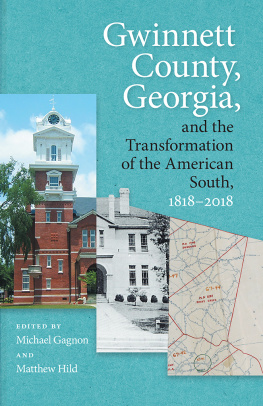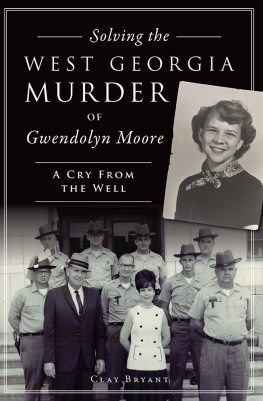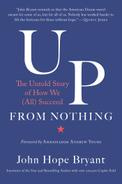1996 The University of North Carolina Press
All rights reserved
Manufactured in the United States of America
The paper in this book meets the guidelines for permanence and durability of the Committee on Production Guidelines for Book Longevity of the Council on Library Resources.
Library of Congress Cataloging-in-Publication Data
Bryant, Jonathan M.
How curious a land : conflict and change in Greene County,
Georgia, 18501885 / by Jonathan M. Bryant.
p. cm.(The Fred W. Morrison series in Southern studies)
Includes bibliographical references and index.
ISBN 0-8078-2257-4 (cloth : alk. paper)
1. Greene County (Ga.)History. 2. Greene County (Ga.)Economic conditions. 3. AgricultureGeorgiaGreene CountyHistory19th century.
I. Title. II. Series.
F292.G7B79 1996 95-23506
975.8612041dc20 CIP
00 99 98 97 96 5 4 3 2 1
THIS BOOK WAS DIGITALLY MANUFACTURED.
Contents
Chapter One
Land Fresh from the Hand of God
Chapter Two
Slaves Sho Did Fare Common in Dem Days
Chapter Three
In the Hands of a Lawyer
Chapter Four
Until Our Country Is Free
Chapter Five
The Winter of the Heart Is upon Us
Chapter Six
We Have No Chance of Justice before the Courts
Chapter Seven
The Time for Action Is at Hand
Chapter Eight
All Right, Set Em Up Again
Chapter Nine
The Old Plantation System Is Played Out
Chapter Ten
We Have a New Class of Men and a New Order of Things
Acknowledgments
An author usually discusses debts in acknowledgments, and I certainly owe thanks to more people for helping me with this project than space permits me to express. Acknowledgments, however, should also include mention of friendship, the sharing of ideas, even the disputes between colleagues. Most important, acknowledgments should recognize the trust and the support given by others, for without them, these books cannot be written.
Throughout this project the most important support came from my family. Miriam Moore-Bryant inspired me with her understanding and her love. She knows a poorly written passage when she reads it, and her advice and ideas have greatly enriched this work. Naomi, Eleanor, and Alexander not only encouraged me to work on the book, but also flattered me by writing and illustrating books of their own. My parents, Miriams parents and her sisters, and many other kin by blood or marriage suspended disbelief and provided financial support, emotional shelter, and plenty of child care. Without my family, I could not have written this book.
Several organizations provided funds for this project. The Phelps-Stokes Fund, the Colonial Dames of Georgia, the University of Georgia, and the University of Baltimore all gave financial support. The Andrew W. Mellon Fellowship in Southern Studies at Emory University allowed me to live a charmed year while I revised this manuscript and did additional research.
Special thanks to Pat Smith and the Greene County Historical Society and Museum, who helped me more than they know. At the Greene County Courthouse Judge Laverne Ogletree, Cindi Christopher, Cindy Baugh, and Ray Marchman all guided me to important records. Marie Boswell, the clerk of court, went out of her way to find materials for me. Mrs. Willie Patience Brown guided me to information on Springfield Baptist Church that I feared was lost. John McMillan gave me access to what remains of Mercer University in Penfield, while Mary Ben Brown proved a jewel, and hospitable besides.
Eli Jackson, who has since died, spent several days guiding me around the county despite his aching eighty-year-old body. He opened doors to the black community I could never have found. A fascinating man, devoted to the cause of justice, Eli Jackson will be missed by me and by Greene County.
I cannot adequately describe the charged atmosphere of creativity and ideas that characterized the graduate program at Georgia in the late 1980s. The particular combination of graduate students and faculty there produced an exciting environment of debate and argument that sharpened all our work. Carolyn Bashaw, Andy Chancy, Stan Deaton, Russ Duncan, Beth Hale, Randy Patton, Chris Phillips, Mary Rollinson, Mark Schultz, Jenny Lund-Smith, Wally Warren, and Brian Wills all created a contentious yet supportive world in which our ideas grew. Glenn Eskews home served as the locus for this group, while Glenn himself played the roles of facilitator, inquisitor, and social director. Of course, I graciously absolve all these persons of any errors in this book.
Mike Belknap, Jean Friedman, Eugene Genovese, Peter Hoffer, Will Holmes, John Inscoe, Claudia Knott, Lester Stephens, and Ben Wall at the University of Georgia represent the best of what faculty can be. At Emory, Dan Carter and Jim Roark shared their ideas and questions about the manuscript with me and gave me their friendship as well. Dan Crofts at Trenton State College gave me much needed advice and moral support. Lewis Bateman at the University of North Carolina Press has shown me that an editor can be a friend and an adviser, while I have just begun to appreciate the professionalism of Ron Maner and Mary Caviness as they helped prepare this book for publication. Finally, my colleagues at the University of Baltimore, especially Cathy Albrecht, John Mayfield, and Jeffrey Sawyer, have been very supportive of my work. My thanks to all.
Three exceptional people gave me gifts that significantly shaped this work. Bud Bartley awakened in me an enthusiasm for history that still drives me today. Emory Thomas gave me the courage to write in my own voice. Bill McFeely gave me his gentle guidance, through which I discovered the humane not just in me but also within an often brutal profession. These three mentors did the most difficult thing, they trusted me, and I hope the result is pleasing.
Ellicott City, Maryland
June 15, 1995
Prologue
Desolation. No other word adequately expresses the feeling of a drive through the redlands of northern Greene County. What once were fertile bottomlands and a rich plantation district known as Prosperity Ridge are now empty lands. Stunted second-growth timber covers most of the region. Occasionally, a pasture or a house trailer hidden in the trees breaks the monotony of the pine-covered landscape; Incredibly, not a single field of cotton appears in what was once one of the richest baronies of the cotton kingdom. The land has changed so that even knowledgeable visitors struggle to discern much of the old world, the world that existed before the people left the land and timber corporations or the U.S. Forest Service bought it.
The present owners are jealous of their rights, as indicated by nicely printed plastic squares posted on trees that detail the legal travails of trespassers. By risking corporate ire, however, an explorer can find many artifacts: rosebushes that once grew in a yard, old wells still full of sweet water, even the foundations of vanished mansions. On cold and cloudy days a sense of despair lingers in the tumbledown tenant cabins, and it can chill an explorers heart.







